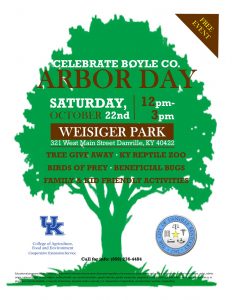Right tree, right place, right way
Published 9:31 am Friday, October 14, 2016
By Alexis Amorese
Horticulture Agent
University of Kentucky
Boyle Co. Cooperative Extension Service
As the weather begins to cool, many of you may be preparing to close up shop in the garden for the year. However, it may not be time to put away your shovels just yet. Fall is actually the perfect time to add a new tree or grouping of shrubs into your landscape.
Planting perennials like trees in the fall, allows enough time for the plant to establish a root system during cooler weather. This makes it more apt to survive next year’s hot summer temperatures. While you may have heard some people say January through March are good planting times, the fall months of September through December have some great advantages. Plant roots will grow anytime the soil is 40 degrees or higher. If the tree is already in the ground preparing for growth over winter, once spring arrives roots are ready for action. Remember though, that while fall may be the best time to plant ball and burlapped trees and shrubs, bare root plants such as roses or fruit trees, should be planted in late winter after the plants have gone completely dormant.

Trees are a long term investment, which is why it is important to pick the right tree for the right place during your fall planting. But what does that mean exactly? There are eight key factors to take into consideration when choosing a tree for a site.
1. Height: will the tree bump into anything when it is fully grown? (power lines, porches)
2. Canopy Spread: how wide will the tree grow?
3. Is the tree deciduous or coniferous? (Will it lose its leaves in the winter?)
4. Form or Shape: a columnar tree will grow in less space. Round and V-Shaped species provide the most shade.
5. Growth Rate: how long will it take for your tree to reach its full height? Slow growing species typically live longer than fast growing species.
6. Soil, Sun, and Moisture Requirements: do you have the right pH? How wet does the soil stay? Is it a sunny or shady spot?
7. Fruit: is the fruit good for wildlife? Will it cause issues when mowing or walking?
8. Hardiness Zone: these indicate the temperature extremes in which a tree can be expected to grow. Boyle County is in zone 6b.
With a little research and a simple layout, you can produce a landscape that will cool your home in summer and tame the winter winds. The National Arbor Day Foundation has created an excellent quiz to help you learn how the characteristics of trees influence when and how they should be planted. You can find it here https://www.arborday.org/trees/righttreeandplace/
Another factor that is starting to have a role in plant selection, is knowing which trees sequester more carbon to decreasing our carbon footprint. Carbon sequestration is a natural, or artificial process by which carbon dioxide is removed from the atmosphere, and held in solid or liquid form. Trees do this naturally through photosynthesis, storing carbon in our soils, with some trees sequestering carbon better than others. On a global scale, the adoption of recommended sequestration technologies such as woodland regeneration has the potential to offset fossil fuel emissions by up to 15% of global emissions per year. (Lal, 2004)
Lucky for us here in the bluegrass, a lot of our native Kentucky trees are great at carbon sequestration, and are also on the list of recommended tree species the City of Danville provides. Oaks, Tulip Poplars, KY Coffeetree, Ginkgo, Black Gum, and Magnolias are just a few that are rated as great carbon sequesters, and are also very tolerant of urban environments. If you are interested in calculating the amount of carbon that is being sequestered by any of your own trees, the Environmental Protection Agency has developed an easy to use calculation that can be found here https://www3.epa.gov/climatechange/Downloads/method-calculating-carbon-sequestration-trees-urban-and-suburban-settings.pdf
Trees are so valuable to us, whether it is by increasing property values, attracting consumers to business districts, improving human health, or decreasing pollutants, we need trees. So, do yourself, and the world a favor this fall, and plant a tree in your yard, or donate to the Wilderness Trace Community Foundation who will be planting trees around the City of Danville. Make sure to come out for the Arbor Day celebration at Weisiger Park on October 22nd from 12-3pm!
Sources:
Lal, R. Soil Carbon Sequestration Impacts on Global Climate Change and Food Security. 2004. Science. 304:1623-1626.





